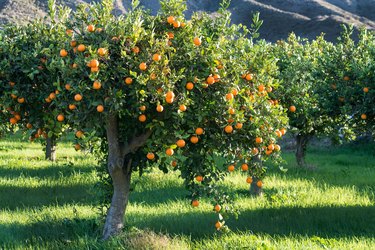
Everybody loves oranges. Maybe its their bright, happy color, maybe their rounded shapes or sweet, juicy fruit. But how much do you really know about oranges and the trees they grow on? Orange tree facts may surprise you. For example, how did the tree and its fruit come to be called "orange?" If you think it was named after the color, you are wrong! And that's just the beginning.
Meet the Orange Tree
Video of the Day
Oranges are juicy and popular citrus fruits that grow on orange trees. These fruit trees grow in subtropical or tropical regions, and are evergreen, holding onto their leaves all winter long. They usually reach a height of about 25 feet, but some long-lived individuals can grow to twice that height over time.
Video of the Day
The orange tree has a single trunk and a rounded crown of slender branches. The oval leaves are fragrant, between 2 and 6 inches long and half as wide. They can been slightly toothed. Gardeners love the magically sweet smell of frothy white orange blossoms, each with five petals. They usually appear in spring.
Orange Fruit
The fruits of the orange tree are also called oranges, and they are actually modified berries. They have tiny glands in pits on the outer rind that contain an essential oil. The inner rind is white and spongy. The pulp of the fruit ranges in color from yellow through orange and red, and it is made up of tightly packed juice sacs in wedge-shaped compartments, often with seeds. These are easily pulled apart into individual segments.
You know that oranges have vitamin C. One orange gives you all the vitamin C you need in a day. But did you know that they are also very rich in fiber? In fact, you'll have to chow down 7 cups of cornflakes to get the same amount of fiber as you do in one orange.
Varieties of Oranges
Some 600 varieties of oranges grow around the world, including sour oranges, sweet oranges, blood oranges (with red pulp) and naval oranges that are seedless and easy to peel. Navel oranges are interesting -- they all came from a single tree planted in Brazil in 1820. Because of a unique mutation, the tree produce two oranges within one single piece of fruit. The second orange develops at the base of the fruit and looks a little like a human navel. It is this second orange that causes navel oranges to be seedless.
Which Came First, the Fruit or the Color?
So why are both the tree and the fruit called "orange?" Which came first, the color or the fruit? The fruit came first. The English word comes from the Old Persian "narang." It meant "bitter" and referred to the bitterness of the peel. Traders spread the fruit to Moorish Spain, where "narang" became "naranja." In Old French, the narang fruit became "orenge," which was picked up in Middle English. It evolved into the modern term "orange," referring both to the fruit and to the color.
Growing Orange Trees
If you live in a warm climate with a hot summer, you may be able to add an orange tree to your backyard orchard. Plant your tree in a full-sun location with some wind protection. Loamy, well-draining, slightly acidic soil is best. Space standard-sized trees 10 to 25 feet apart.
Orange trees need regular irrigation and feeding with citrus-specific fertilizer. They are healthy trees, but occasionally can be attacked by aphids, spider mites or fruit flies, or susceptible to root and crown rots, or fungal leaf spots. However, don't be too concerned. More orange trees are killed by lighting strikes than by plant diseases.